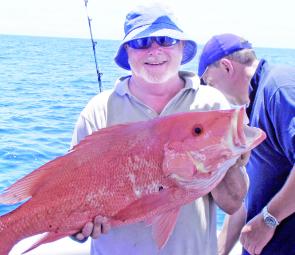The blue ribbon date on the angling calendar when the barra season opens is 1 February, bringing hordes of anglers to boat ramps armoured with an array of accessories to target big brutes.
Where to go and what to apply can be a daunting task, especially for beginner or intermediate anglers. But when chasing barra it is important to factor in the conditions and the amount of rainfall into your target formula. Finding a patch of water with a higher concentration of saltwater as opposed to fresh is also a must. A lot of rain does make the fishing tough, but if the rains are moderate, headlands and mangrove flats become prime spots where bait has been flushed, and prime spots for predators. Small run off creeks just inside rivers and creeks also become a rich source of food on a dropping tide.
Those prepared to cover more ground and explore every nook and cranny will eventually find a holding office of barra. Throwing lures or even trolling on the edges of dirty and clean water is a great way to establish where the fish are ambushing. Once found, live baiting, fishing soft plastics and even casting a popper deliver results. Good luck in your pursuit.
As the wet season progresses reef fishing has become a touch more challenging with either swinging light breezes or the opposite in lumpy conditions. Catches have been patchy mainly in the name of coral trout, sweetlip or stripey's in shallower waters. On days where anchoring in deeper water over rubble patches or isolated bommies has allowed, there are still enough large and small mouth nannygai to make the effort worthwhile. Quality rather than quantity is the order on the reds. Changes of the tide has been paramount where most catches have occurred.
Other species to create a mixed bag have been bludger and gold spot trevally. Also the odd reef jack, cobia or big Spanish mackerel have been taken on live floating bait, but this is the exception rather than the norm. In February we can expect similar catches associated with more challenging conditions.
Game boats by now have well and truly reverted back to light tackle gear and have had success out wide with yellowfin tuna, mahi mahi and smaller wahoo. The last of the marlin catches were recorded just prior to Christmas. The best method now is to trail a variety of hard body and skirted lures and search for birds feeding on boiling bait schools. On the way out to the shelf there are plenty of smaller mack tuna schools in the paddocks to turn a few reels and gain some practice. Another option is to stop at these feeding tuna and spin 20-25g metal slices on light gear, which is always a heap of fun.
The beaches have had a new lease of life with a rush of bait spread up and down the coastline. With the seed planted and plenty of rain, all we need is for the sun to come out and watch this fishery grow to fruition. After a few settling days one could expect to mingle with trevally, queenfish, blue salmon, tarpon, flathead and barra. Concentrate efforts within the vicinity of a rivers or creek mouths no matter how small a system it is. Often the most inconspicuous of water entering the sea can hold many predators waiting in ambush not too far from shore.
Lure, fly and live bait fishing will all produce handsomely if we receive a calm spell. This was certainly the case around Christmas and New Year. Low light periods have been quite good, but even an overcast day can see the action more spread out.
With moderate rains following the New Year the local rivers and creeks were superb for mangrove jack and fingermark. February brings the added bonus of a potential barra if we can avoid flash flooding. There has also been a swag of small bait just inside systems and the incoming tides brought on the queenfish and trevally of medium size. One would think though this bait will have now been dispersed along our beaches and headlands where you should see action on the pelagics.
With a heavy cyclone season predicted and plenty of rain ahead, wait for the gap between the bad weather and go for it, even if the window is small.
Reads: 1449
Dragon Lady charters are still sourcing quality large mouth nannygai. Try anchoring in deeper water over rubble patches or isolated bommies.




